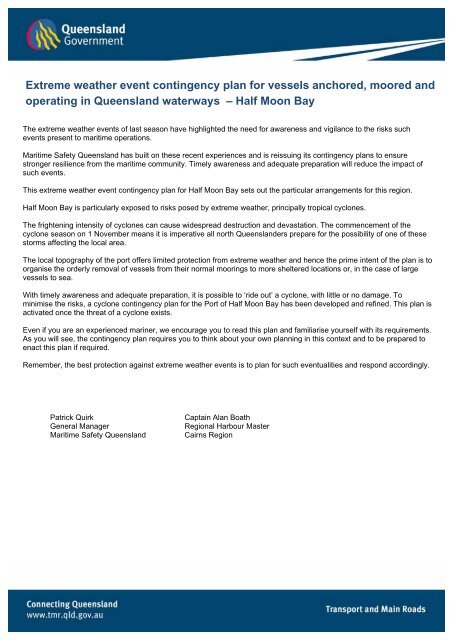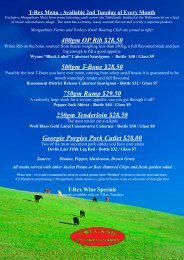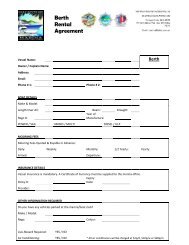Half Moon Bay Marina Cyclone Contingency Plan - Yorkeys Knob ...
Half Moon Bay Marina Cyclone Contingency Plan - Yorkeys Knob ...
Half Moon Bay Marina Cyclone Contingency Plan - Yorkeys Knob ...
Create successful ePaper yourself
Turn your PDF publications into a flip-book with our unique Google optimized e-Paper software.
Extreme weather event contingency plan for vessels anchored, moored and<br />
operating in Queensland waterways – <strong>Half</strong> <strong>Moon</strong> <strong>Bay</strong><br />
The extreme weather events of last season have highlighted the need for awareness and vigilance to the risks such<br />
events present to maritime operations.<br />
Maritime Safety Queensland has built on these recent experiences and is reissuing its contingency plans to ensure<br />
stronger resilience from the maritime community. Timely awareness and adequate preparation will reduce the impact of<br />
such events.<br />
This extreme weather event contingency plan for <strong>Half</strong> <strong>Moon</strong> <strong>Bay</strong> sets out the particular arrangements for this region.<br />
<strong>Half</strong> <strong>Moon</strong> <strong>Bay</strong> is particularly exposed to risks posed by extreme weather, principally tropical cyclones.<br />
The frightening intensity of cyclones can cause widespread destruction and devastation. The commencement of the<br />
cyclone season on 1 November means it is imperative all north Queenslanders prepare for the possibility of one of these<br />
storms affecting the local area.<br />
The local topography of the port offers limited protection from extreme weather and hence the prime intent of the plan is to<br />
organise the orderly removal of vessels from their normal moorings to more sheltered locations or, in the case of large<br />
vessels to sea.<br />
With timely awareness and adequate preparation, it is possible to ‘ride out’ a cyclone, with little or no damage. To<br />
minimise the risks, a cyclone contingency plan for the Port of <strong>Half</strong> <strong>Moon</strong> <strong>Bay</strong> has been developed and refined. This plan is<br />
activated once the threat of a cyclone exists.<br />
Even if you are an experienced mariner, we encourage you to read this plan and familiarise yourself with its requirements.<br />
As you will see, the contingency plan requires you to think about your own planning in this context and to be prepared to<br />
enact this plan if required.<br />
Remember, the best protection against extreme weather events is to plan for such eventualities and respond accordingly.<br />
Patrick Quirk<br />
General Manager<br />
Maritime Safety Queensland<br />
Captain Alan Boath<br />
Regional Harbour Master<br />
Cairns Region
Objective of this plan<br />
The overall objective of this plan is to provide for the safety of vessels and their operation during extreme weather events.<br />
Personal safety is of prime importance at all times.<br />
An extreme weather event may require the evacuation of the port. In such instances, the regional harbour master’s<br />
objective is to have the port area evacuated and for all vessels to have enacted their own safety plans between forty eight<br />
and six hours before the event impacts. The plan is to organise the orderly removal of vessels from their normal moorings<br />
to more sheltered locations or, in the case of large vessels to sea. The creeks and waterways off the Trinity Inlet, within<br />
the mangrove areas, offer the best shelter and protection for small vessels.<br />
All vessels, other than those being used for emergency purposes are to evacuate and clear the port area. Owners should<br />
be aware that, should they leave their vessel in the port area, they may be liable to prosecution and, additionally, be held<br />
accountable for any damage that their vessel may cause or incur to other infrastructure.<br />
Masters should be aware of the sudden onslaught of cyclones during the wet season and should take adequate<br />
precautions to have their vessels ready to depart at short notice. When the meteorological office advises that a strong<br />
tropical depression or cyclone is likely to form, Masters will put their vessels on standby to sail. The Harbour Master’s<br />
requirements for clearing the port of large vessels will generally be:<br />
wind speeds must not have reached 30 knots<br />
ships must be able to sail, for example, machinery working and crew on board<br />
the ship must be in a suitable trim to sail<br />
the ship’s deepest draft must give suitable clearance when sailing.<br />
Master’s and owner’s responsibility in regard to this plan<br />
Masters and owners of vessels have an obligation under the Transport Operations Marine Safety Act 1994 at all times to<br />
take appropriate precautions for the safety of their vessels, passengers and crew.<br />
In extreme weather conditions, the regional harbour master may give directions in relation to the operation and movement<br />
of vessels within their jurisdiction. Masters and owners are required to follow such directions.<br />
Masters and owners need to familiarise themselves with this plan, determine and develop the most appropriate safety<br />
plan for their vessel and respond in accordance with any directions. Masters and owners are also required to monitor<br />
developments to ensure that they have the most up-to-date information on weather conditions and any directions in place.<br />
Masters and owners are required to notify Maritime Safety Queensland of any changes to the following:<br />
vessel ownership<br />
residential address<br />
contact telephone numbers.<br />
This up-to-date contact information is vital for an immediate response to any port emergency. Failure to provide correct<br />
details of vessel ownership is an offence under the Transport Operations (Marine Safety) Act 1994.<br />
Unless absolutely unavoidable, all owners of vessels on the water should ensure their vessel is capable of moving without<br />
assistance or have alternative means of moving their vessel, particularly during extreme weather event peak seasons (for<br />
example cyclone seasons). Failure to do so may present an unacceptable hazard to the vessel, as well as other vessels<br />
and infrastructure. This may cause an owner to incur towage expenses.<br />
If you are unable to attend to your vessel at short notice for any significant duration, particularly during the tropical cyclone<br />
season, you are to make arrangements with a person that can act on your behalf in the event of an extreme weather<br />
event. That person will be responsible to implement your safety plan. The local contact person must attend to the vessel<br />
no later than when a Yellow Alert has been declared for <strong>Half</strong> <strong>Moon</strong> <strong>Bay</strong> <strong>Marina</strong> and make appropriate preparations.<br />
.<br />
Extreme weather procedures in detail<br />
In the event of an extreme weather event threat the regional harbour master will take the following action:<br />
restrict the movement of vessels if necessary<br />
direct and oversee the evacuation of the port or specific areas of the port or other affected areas if applicable<br />
Extreme weather event contingency plan – <strong>Half</strong> <strong>Moon</strong> <strong>Bay</strong>, Maritime Safety Queensland, November 2011 2 of 8
close and reopen the port if necessary.<br />
The regional harbour master will also:<br />
advise mariners of relevant warnings and response requirements<br />
seek compliance with the response requirements.<br />
These actions will be enacted over four distinct phases that allows for the development of appropriate responses to the<br />
threats faced.<br />
Phase 1: Extreme weather event watch. – Prevention<br />
An extreme weather event watch will be issued when an extreme weather event or developing event is likely to affect the<br />
area within 48 hours, but not expected to impact the area within 24 hours. This phase is a critical time for masters and<br />
owners to plan and prepare for the impact of the event.<br />
During this period, masters and owners (or their representatives) should review their safety plans and address any<br />
matters outstanding (for example refuelling and provisioning).<br />
Phase 2: Extreme weather event warning - Preparedness<br />
An extreme weather event warning will be issued when an extreme weather event or developing event is likely to affect<br />
the area within 24 hours. This phase is critical for masters and owners to complete all preparations in an orderly manner<br />
prior to the event occurring.<br />
The Regional Harbour Master (Cairns) will direct the evacuation of the port with the assistance of personnel from <strong>Marina</strong><br />
Management to regulate and control the movements of vessels. Vessels must proceed as far as possible upstream in the<br />
designated shelter areas so as not to impede the progress of others. It is also important to be alert during the ‘eye’ of the<br />
cyclone as a period of calm may be experienced before the winds resume from the opposite direction. Vessels should not<br />
return to their normal berths until officially advised it is safe to do so. The best protection against the destructive forces of<br />
cyclones is to be prepared for them. See the accompanying chartlet (appendix A).<br />
The port has established a three tier alert status.<br />
Yellow Alert - destructive winds forecast within 24 hours.<br />
If a Yellow Alert is issued, the port will:<br />
suspend loading of all ships, obtain a situation report on state of loading, draft, and so on<br />
inform ships’ masters of situation and place a short notice to sail<br />
obtain information on length of time to bring ships to a readiness to sail<br />
inform Regional Harbour Master (Cairns) of situation and ascertain suitable sailing times, draft requirements, and so<br />
on.<br />
if time and draft permit, resume loading. Bring load to satisfactory handling trim.<br />
During a Yellow Alert small vessels should move to designated cyclone mooring areas of the creeks and waterways off<br />
the <strong>Moon</strong> River within the mangrove areas. To ensure an orderly evacuation, the Regional Harbour Master (Cairns) will<br />
announce a schedule of evacuation over VHF channel 16. Mariners will observe and follow this schedule.<br />
When conditions are deteriorating, every endeavour will be made to accommodate the working of cargo in the available<br />
time, allowing for tidal constraints.<br />
Blue Alert - destructive winds forecast within 12 hours<br />
If a Blue Alert is issued, the port will direct all ships to sea noting that it may already have been necessary to have sailed<br />
some ships due to tidal conditions. In the event that a ship cannot sail, the port will arrange linesmen and instruct master<br />
to take standard cyclone precautions<br />
On water authorities will prepare to depart. All small vessels should be moored in their designated area and final<br />
preparations and tying off completed.<br />
Extreme weather event contingency plan – <strong>Half</strong> <strong>Moon</strong> <strong>Bay</strong>, Maritime Safety Queensland, November 2011 3 of 8
The anchoring of large vessels upstream is not recommended due to tidal surges that could inundate the area, which, with<br />
high winds, may well strand vessels inland of the river system, making any salvage extremely difficult.<br />
Red Alert - Destructive winds forecast within six hours<br />
At this stage the port will be closed. See the wording under phase 3 for further information.<br />
Phase 3: Actual extreme weather event - Response<br />
By this phase, all vessels are expected to have enacted their vessel safety plans noting that the port is likely to be closed<br />
and/or vessel movements restricted depending on the threat to safety of vessel movements or the environment. Your<br />
actions should be directed towards your own personal safety.<br />
Mariners should maintain a listening watch on VHF channels 16 and 12 and follow advice/directions from Cairns Vessel<br />
Traffic Service, (Callsign Cairns VTS).<br />
It is also important to be alert during the ‘eye’ of the cyclone as a period of calm may be experienced before the damaging<br />
wind force resumes once the eye has passed.<br />
Vessels are not to leave their cyclone moorings until the official all clear is given by the Regional Harbour Master (Cairns).<br />
Phase 4: After the extreme weather event has passed - Recovery<br />
The regional harbour master will assess residual risks and determine the actions needed to be addressed. Do not<br />
assume that as the extreme weather event has passed, it is now safe to move your vessel.<br />
Mariners should maintain a listening watch on VHF channels 16 and 12 and follow advice/directions from Cairns Vessel<br />
Traffic Service, (Callsign Cairns VTS).<br />
Vessels are not to leave their cyclone moorings or return to the port or anchorages until the official all clear is given by the<br />
Regional Harbour Master (Cairns). Mariners should maintain a listening watch on the key VHF frequencies (see the<br />
communication section).<br />
Movements can be at the regional harbour master’s discretion and can be in stages including limiting movements to the<br />
internal port only until the channel or areas within the port are deemed safe.<br />
Owners and masters of vessels should be aware that aids to navigation may be affected by the extreme weather event.<br />
Owners and masters should reference Notices to Mariners for the latest updates. Furthermore, port infrastructure will<br />
need to be inspected to ensure that facilities are fit for purpose.<br />
Port Closure<br />
The regional harbour master may close the port, wholly or in part, or restrict the movement of vessels in the pilotage area,<br />
commensurate with the threat to the safety of shipping or the environment. This can occur at any time prior to the event.<br />
The closure of the port or restriction on vessel movements will, as far as practical, be implemented in consultation with<br />
key authorities and in a timely manner in order to minimise risks.<br />
Reopening of the port<br />
The pilotage area will not be re-opened until the regional harbour master is satisfied that all danger has passed, and the<br />
pilotage area is safe for vessels to re-enter and following inspections and surveys to critical maritime infrastructure<br />
(for example navigational aids and wharfs) as well as clearance of navigational hazards.<br />
The Vessel Traffic Services Centre will coordinate the safe movement of vessels following the opening of the pilotage<br />
area in accordance with normal practice. Berths will be re-opened and operations resumed when wind and sea conditions<br />
are within operational limits.<br />
Extreme weather event contingency plan – <strong>Half</strong> <strong>Moon</strong> <strong>Bay</strong>, Maritime Safety Queensland, November 2011 4 of 8
Communication<br />
The successful implementation of this plan relies on high quality communication of information and directions.<br />
From the commencement of Yellow Alert, the <strong>Yorkeys</strong> <strong>Knob</strong> Boating Club will become the <strong>Half</strong> <strong>Moon</strong> <strong>Bay</strong> Emergency<br />
Control Centre (ECC). The ECC will monitor VHF channel 16/27Mg channel 88 and telephone 4055 7711.<br />
The ECC will relay messages from the Regional Harbour Master (Cairns) and act as co-ordination and control centre.<br />
Once in position, all vessels are to contact the ECC and advise them of the area in which they are moored and how many<br />
people will be remaining on board. If a vessel is to be left unattended, its owners are to advise the control centre of their<br />
contact telephone numbers.<br />
To ensure an orderly evacuation, the Regional Harbour Master (Cairns) will announce a schedule of evacuation over VHF<br />
channel 16. Mariners will observe and follow this schedule.<br />
Key Contacts<br />
Name<br />
Contact Number<br />
Regional Harbour Master 07 4052 7412<br />
Ports North 07 4051 2558<br />
Boating & Fisheries Patrol 07 4035 0703<br />
<strong>Yorkeys</strong> <strong>Knob</strong> Boat Club 07 4055 7711<br />
Water Police 07 4057 3577<br />
Vessel Traffic Services 1300 551 899<br />
Key Websites<br />
Detailed weather updates:<br />
MSQ Website<br />
www.bom.gov.au<br />
www.msq.qld.gov.au<br />
Extreme weather event contingency plan – <strong>Half</strong> <strong>Moon</strong> <strong>Bay</strong>, Maritime Safety Queensland, November 2011 5 of 8
Appendix A.<br />
Extreme weather event contingency plan – <strong>Half</strong> <strong>Moon</strong> <strong>Bay</strong>, Maritime Safety Queensland, November 2011 6 of 8
Appendix B<br />
Your safety plan<br />
The master or owner’s responsibility is at all times to take appropriate precautions for the safety of their vessels,<br />
passengers and crew.<br />
All masters and owners should have developed a vessel safety plan in response to extreme weather events. The plan<br />
should take into account the most likely risks arising from the hazards presented for your region.<br />
You should trial your plan to ensure that it can be enacted competently and rapidly. Do not wait until the last minute to<br />
plan and prepare your response to extreme weather risks.<br />
General considerations<br />
A well prepared vessel with fully functional equipment is a key element to a successful safety plan.<br />
Ensure that your vessel is in a seaworthy state<br />
Maintain your vessel to ensure that deferred maintenance does not compromise the seaworthiness of your vessel at<br />
critical times. Check that all bilge pumps are operational and that all self-draining openings are clear and will remain<br />
so. Make sure all safety equipment is available, in working order and up-to-date where applicable (for example flares).<br />
Check all cleats and associated fittings for integrity. Generally, mooring lines are stronger than these. Keep storm<br />
anchors, spare warps and spare fenders ready at hand but well secured to prevent them creating a potential hazard in<br />
the event you must move the vessel. Securely stow all loose items. Secure all hatches and vents. Provision your<br />
vessel with fresh water, food and fuel and ensure that the batteries are charged.<br />
Ensure your mooring arrangements are up for the job at hand<br />
Check all mooring lines and warps for chafing and deterioration and replace if necessary. Man-made synthetic fibres<br />
such as polyethylene, polypropylene and polyester deteriorate in the sunlight and may show little signs of<br />
deterioration prior to failure. You should have a schedule worked out to replace mooring lines in accordance with<br />
manufacturer’s recommendations. Allow for a sufficient number of mooring lines so that you can double up your<br />
mooring arrangements. Have sufficient fenders for the anticipated mooring arrangements. Check anchor chains,<br />
shackles and anchor warps for wear and replace if necessary. If you intend to utilise a swing mooring, ensure that the<br />
mooring chain has been recently inspected. You should also be aware that flooding events resulting from extreme<br />
weather events may result in build-up of debris around the mooring chain, compromising the integrity of the mooring<br />
arrangement.<br />
Reduce wind loadings<br />
Remove all deck gear including lifebuoys, dodgers, bimini covers, clears and so on and store below. Remove sails,<br />
self-furling sails and covers. If this is not possible, double wrap or tie these components in such a way that the wind<br />
cannot tease any ends out and allow flapping of gear to commence.<br />
Secure your tender<br />
Ideally, tenders should be stored in dinghy lockers, garaged or deflated and stowed if applicable. If stored with the<br />
vessel, tenders should be securely lashed inverted on deck to prevent filling with water – do not contemplate towing<br />
tenders. If left on purpose-built davits, tenders should be cleaned out and securely lashed and bungs removed.<br />
<strong>Marina</strong>-based safety plans<br />
<strong>Marina</strong>-based plans may be appropriate for your region. You should note that the design and construction of marinas<br />
requires the consideration of the likely range of weather conditions that might be experienced so that the overall structures<br />
would withstand the expected loads including storm surge while vessels are moored in the berths.<br />
Notwithstanding the care which was taken in establishing design and construction criteria that were considered to be<br />
appropriate, no guarantee can be given that the structures are capable of maintaining their integrity in the complete range<br />
of extreme weather conditions. Remember vessels are moored at owners’ risk and it is the owner’s prerogative to move<br />
their vessel if they feel insecure in the marina, noting that any vessel movement should occur in line with the extreme<br />
weather contingency plan for the port.<br />
Extreme weather event contingency plan – <strong>Half</strong> <strong>Moon</strong> <strong>Bay</strong>, Maritime Safety Queensland, November 2011 7 of 8
In addition to the general points made above, marina-based safety plans need to consider the following issues. It is<br />
important that you discuss this with your marina management to understand their requirements so that your plan is<br />
consistent with marina operations:<br />
The loadings on marina berths<br />
Some marinas allow for berths to remain occupied provided the berth has a pontoon equivalent to the overall length<br />
(LOA) of the vessel occupying it. Vessels may also be allowed to bear against the fingers/pontoons noting that<br />
suitable or additional fendering is likely to be required.<br />
Mooring considerations<br />
Double up mooring lines, by running duplicated ropes to alternative bollards. Do not run duplicates to the same<br />
bollards – a single bollard failure should not release the craft from a safe mooring arrangement. The duplicate lines<br />
should be in good condition and run slightly slack to ensure that they are only required to work in the event of the<br />
chafing through the primary mooring lines. Vessels should not be secured to piles as this prevents pontoons moving<br />
with tidal and surge movements. Take particular care to protect against chafing. Ensure lines are made fast to<br />
substantial boat parts, for example mast steps, winches and so on, bearing in mind cleats are known to have been<br />
torn out of decks. Do not use chain to secure your boat to pontoon bollards. Chains have no ability to stretch, where<br />
ropes have a certain amount of give. Some marinas allow for anchors to be lowered in the marina berth to the sea<br />
bottom. Ensure there is enough slack to rise and fall of the vessel due to swell and storm surges. If the master or<br />
owner elects to stay on-board with the vessel, any mooring lines should be adjustable from onboard and sufficiently<br />
taut to ensure the vessel and pontoon move as one.<br />
Other factors<br />
You are likely to be required to disconnect all shore power leads and water hoses. Some marinas have particular<br />
arrangements for the stowage of vessel tenders. <strong>Marina</strong> management may determine the time when personnel are<br />
barred from the pontoons and/or hardstand areas. Ensure that you abide by any such direction.<br />
Hardstand storage<br />
Hardstand storage is a viable alternative for trailer vessels or vessels undergoing maintenance. However, vessel windage<br />
is considerably increased through hardstand storage. In such situations, owners and masters of vessels should:<br />
<br />
<br />
<br />
<br />
place the vessel head to the wind if possible<br />
take particular care to secure and stow all deck items<br />
ensure wheels are chocked and trailer brakes applied<br />
attach the trailer or cradle to the nearest strong point(s).<br />
You should note that flying debris, particularly in the hardstand areas, can cause serious injury or may be lethal during a<br />
severe weather event. Please exercise all due care when operating in these areas.<br />
Extreme weather event contingency plan – <strong>Half</strong> <strong>Moon</strong> <strong>Bay</strong>, Maritime Safety Queensland, November 2011 8 of 8






